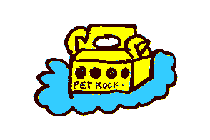



As mentioned previously in the Postmodern Pet Tour, pet-keeping is a very expensive activity. In 1994, Americans spent around $8.5 billion annually on dog and cat food, and spent over $7 billion on veterinary care for pet dogs, cats and birds (Serpell 14). In addition, according to 1994 figures, animal bites and scratches cost over $120 million per year in the United States (Serpell 15). It was also said that the problem of dog bites affect "more than 1% of the US population annually and accounting for widespread exposure to zoonotic diseases and more than 20 fatalities each year" (Serpell 15). No wonder Gary Dahl, a California advertising man, considered "dogs, cats, birds, and fish all a pain in the neck" (Stern 379).
He felt that "they made a mess; they misbehaved; they cost too much money" (Stern 379). And as the inventor of the "pet rock", he suggested that the pet rock is "an ideal pet - easy and cheap, and it had a great personality" (Stern 380). Though his geological pets were only sold at $3.95 apiece, but in just a few months, Dahl had already become a millionaire (Stern 380). This commodity, that bears the name "pet", is indeed very profitable. Many entrepreneurs flooded the market with dozens of copycat rocks. Some said that, "if you find one that claims to be the 'Original Pet Rock', it is actually one of the copies" (Super70s.com). The market appeared to show a postmodern phenonmenon -- the Xerox-degree of culture. Customers were no longer able to tell which were "the originals" as they all claimed to be the one.
On the other hand, as mentioned earlier, a pet is defined as "an animal kept for amusement or companionship" (www.dictionary.com). Pet rocks are only "uniform-size, rounded gray pebble that sold for a penny" at Rosarita Beach in Baja, Mexico, packaged in a gift box shaped like a pet carrying case, accompanied by the "Pet Rock Training Manual" (Stern 380). They are not "animals". The inventor picked the name "pet" arbitrarily. From the postmodernist perspective, pet rocks are simulacra. Postmodern theorist Jean Baudrillard described that "a simulacrum is a copy or reproduction of the real, and traces the steps by which it progressively assumes an autonomous status, divorced from the real" (Taylor 368). Pet rocks are packaged in gift boxes that imitate real pet-carrying cases. However, the rocks inside do not resemble the appearances or personalities of the common pet-animals at all. They provide one with a "pet-keeping" experience that is much cheaper and cleaner, or in other words, better than the real.
Sadly, this ingenious postmodern commodity invented in April 1975 had already become last year's fad by Christmas 1975 (Stern 380). And to the Y2K generation, pet rock is definitely not the hottest subject of the day. When they find that some websites are selling a "nostalgic" product named pet rock miniature key chain (www.stupid.com), many comment that they are "incredibly useless and stupid".See bibliography for photo credits.
Pet Rocks Inventor:
Pet Rocks 1975:
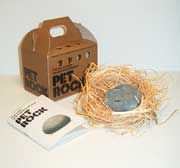

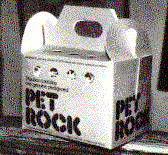
Pet Rocks with Caveman Yo-Yo 1975:
Pet Rocks Manual1975:
Left to right: (1) Teach your pet rock to attack. (2) Different breeds of pet rocks. (3) A chip off an old rock is more serious than a chip off a young rock.
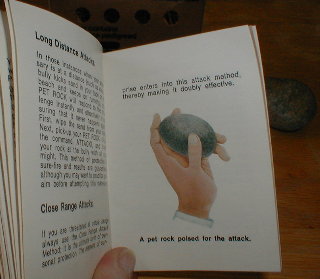
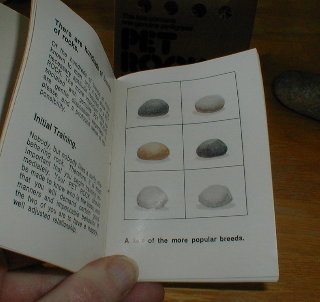
Left to right: (1) How to tell a healthy rock from a rock in distress. (They both look alike in the picture.) (2) Obedience Training. (3) Warning about a pack of wild rocks.
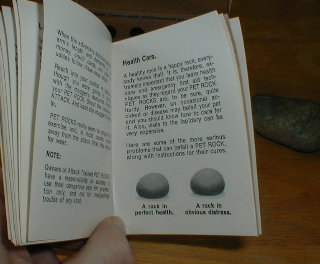
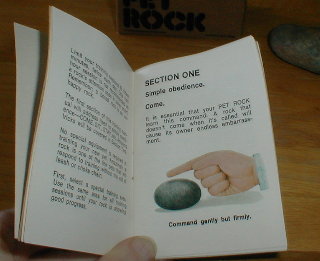
Giving your rock a place of its own, a ticking alarm clock to sooth it if it's nervous upon arrival and putting down newspapers, just in case.
Pet Rocks Miniature Key Chain 2002 (Comes with Manual):


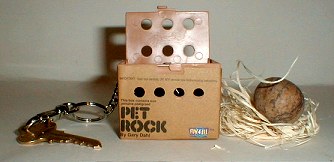
Go back to see other flying postmodern virtual pets...